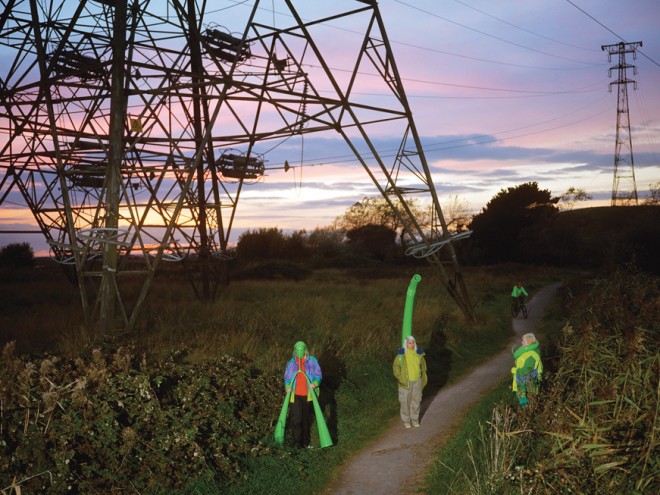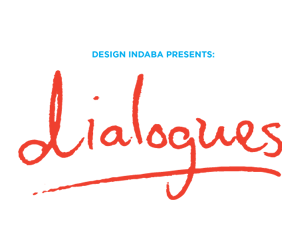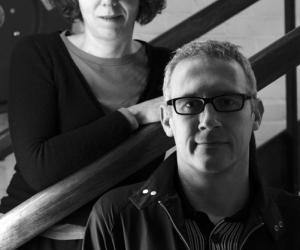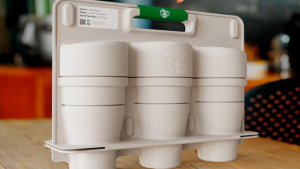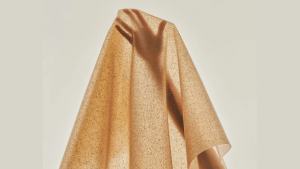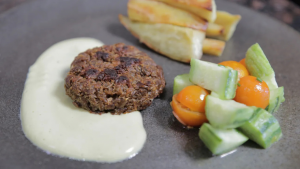Part of the Project
First Published in
Paola Antonelli: For the past ten years I have been working on a book project, which now might become an exhibition, about basic food units from all over the world, considered as examples of design. Since it was my own project and not for MoMA, I’ve been postponing and postponing, although I have done all the research. Now I am proposing it to MoMA as a show, so that I’ll finally do it!
Marion Nestle: It’s the right time for it because everybody is doing food.
Paola: You’ve been doing food for a much longer time. How did you get to food as the focus of your work?
Marion: I’ve always loved to eat and I was introduced to real food at a summer camp when I was eight years old. I was sent off to this camp in Vermont where they had a garden and a wonderful cook. The cook would send the kids out to the garden to pick the food. Once you’ve eaten freshly picked vegetables, you can’t go back.
When it came time to go to university I wanted to study food but it wasn’t possible. You had two choices. You could study agriculture, but I’m a city girl. The other possibility was dietetics. I went to university as a dietetics major and lasted exactly one day.
Paola: One day! I thought you were about to say one year. Why, what happened?
Marion: Well, I went to the first class and thought: “This is silly, I’m not going to do this.”
Paola: Good for you. It took me two years to leave economics.
Marion: Ah yes, economics. I regret not knowing agricultural economics, which would be helpful.
But so, I left it and did science. I did my doctorate in molecular biology. I ended up teaching cellular and molecular biology, which was very abstract although very aesthetic. In my department at Brandeis in Massachusetts there was a rule that you could only teach the same class for three years. Then you had to stop and teach something else, whether you knew anything about it or not, because the idea was that you would always be learning, changing, and keeping the teaching fresh. When it was my turn to do a new course, the students wanted a nutrition course and it was handed to me to teach. It was like falling in love; I never looked back. In that first class I established the way that I would be thinking and teaching about food and nutrition ever since. It’s now been almost 40 years.
After that I went to the medical school in San Francisco (UCSF) where I taught nutrition to medical students for ten years. In between I did a Master’s in public health nutrition that linked what I was doing to social questions. By the time I went to Washington to work on government policy for a couple of years, I knew basic nutrition, clinical nutrition and public health nutrition. After two years learning nutrition policy, I went to New York University.
Paola: I think there are few things in the world that can condense as much as food. You can approach it in so many different ways. It can be art. It can be literature. It can be policymaking.
Marion: It can be biology. I knew right from the first day that this was the best way to teach biology. When I was talking to students in my classes about cellular and molecular biology, their eyes glazed over. It is very abstract. You can’t see it, smell it or touch it because these things are very small; you need microscopes. Food, on the other hand, is practical. Everybody eats.
Paola: This is the same reason why I want to use food to explain to people that design is not just cute and expensive chairs. If you eat it, then you can understand it.
So, what do you think about the “molecular cuisine” term that is used so much?
Marion: [Laughs] Well, actually, when my partner and I went to elBulli…
Paola: You did?
Marion: Oh we did!
Paola: Was it a good experience?
Marion: It was a great aesthetic experience. The presentations were exquisite. Everything was served on these interesting, curved objects that you would never think of as plates. But the taste didn’t live up to it.
Paola: I’m not surprised but it is just funny that it all comes full circle and you get molecular cuisine.
Marion: It was very funny actually because it is very bad science. It is very trivial science. I went to a demonstration recently and they make a very big deal out of emulsions when these are not all that complicated. There is not very much science involved, but people love the idea.
Paola: When you say food, there are so many ways to think about it. I always think in terms of scale and architecture; in the way the food units are design while the plates become more architectural. Then there is also the primal matter, discussed in books like Salt and Cod by Mark Kurlansky, for instance, which are so fascinating because they talk about food as a material. Cod could almost be considered concrete…
When did you start your activist take on food?
Marion: I’ve always been an activist so it was very easy to start teaching food and nutrition, see how the political system influenced what people ate and also make that connection for students. It didn’t come as a big discovery. In that first class in the mid-1970s I had students read a series of articles from the New York Review of Books about sugar subsidies and how the agricultural system supported politically powerful sugar growers.
Paola: So that was before the big corn controversy.
Marion: Yes, before corn. We were supporting a small number of USA farmers to grow sugar and sell it at a higher price. Here I am today teaching a course on the Farm Bill at NYU and talking about exactly the same problem with sugar and the opposite problem with corn.
Paola: The Farm Bill and not Farmville…
Marion: I’ve never seen Farmville.
Paola: You’ve never seen Farmville?
Marion: No, because you have to log on and I don’t want to do all of that.
Paola: Yeah, you have to log onto Facebook, which is also one of the reasons why I don’t do it, but it’s interesting. There’s policymaking and then there’s education, and education can do a lot for policymaking. One approach to education is gaming, but I don’t know if that is the case with Farmville.
Marion: I consider Farmville to be a gap in my education!
Paola: When you were in Washington, what kind of policies were you working on?
Marion: I was in the Department of Health and Human Services with a very fancy title – “Senior Nutrition Policy Advisor” – the same title that the chef in the White House, Sam Kass, now has! I produced and edited a 700-page book on diet and chronic disease prevention while I was there.
Paola: Did it become legislation at all?
Marion: No, it was the first federal report that linked diet to the risk of heart disease, cancer and diabetes in 1988. It was a big research report, quite controversial and famous for telling everybody that they should eat less fat, which was very naïve.
Paola: Why naïve?
Marion: Well, it never occurred to the people working on the report that in taking the fat out of food, the food industry would replace it with sugar. I don’t think anybody realised how fiercely the food industry was going to oppose any advice that people should eat less of their products.
Paola: What do you think of the attempts to regulate food right now? There are no more trans fats in restaurants in New York City. What do you think about the legislation that now wants to tax sodas?
Marion: It is an amusing idea, mostly because I think soda companies are completely out of control in how they are pushing products, especially on young people. Anything that sets them back a little is probably helpful. The first thing you do if you’re trying to lose weight is to stop drinking sodas.
Paola: Even sugar-free sodas?
Marion: You probably shouldn’t even do sugar-free sodas, even though they don’t have calories, because it keeps the taste going.
Paola: Ah, so you think there should be a re-education?
Marion: Oh no, I think it should be policy. Education doesn’t work.
Paola: No, I meant policy to re-educate.
Marion: Education of individuals isn’t enough. You need policies that make it harder to eat things that aren’t good for you and easier to eat things that are good for you. Unfortunately our economic system doesn’t promote that.
Paola: Many designers today are working in a realm that is called “critical design”, especially at the Royal College of Art in London. There is one piece that we just acquired for the MoMA collection called “Foragers”, which was actually initiated by Design Indaba. It’s by Dunne & Raby, who are like the godparents of critical design. In the project, because of the scarcity of food in the future, Dunne & Raby show us trying to go back to digesting things that we haven’t digested in centuries, like roots and algae. We do so by outsourcing our gastro-intestinal system to different apparatus and machines.
These designers highlight critical issues with beautifully crafted scenarios that are filled with imagination, and that simply point in the direction of possible consequences. It is interesting to see how many people are working with the means at their disposal, which in some cases is data and research, and in other cases performances, trying to warn us about the food problem that is happening worldwide.
Do you do much research for the developing world or are you mostly focussed on the USA? Growing up in Italy, when I didn’t finish my food, my grandmother would say: “Think of the children in Biafra.”
Marion: For us it was the starving children in Europe!
Paola: [both laugh] But, do you have a take on the First World’s attitude towards the developing world when it comes to food?
Marion: They make our food at a very low cost, or at least the raw materials. Chocolate is the best example. The Third World raises the plants and collects the pods, and then we turn it into very expensive chocolate and they don’t get much money for it. The same is true of coffee, bananas and sugar.
Paola: This is one of those questions that I get very angry about when journalists ask me, but do you think that there’s hope for any kind of balance developing from all these issues in the world?
Marion: Only if people become more political. This is also another way in which using food is an easier way to teach people. It’s easier to understand the political economy of food than it is to understand how our economic systems promote climate change or income disparities or whatever. You can do it through food and people are more likely to listen.
Paola: Do you see any examples of better education towards a more political approach to food in Europe for instance?
Marion: Oh yes. The Scandinavian countries do all those things better. They have such a different view of the role of food in society that of course children are fed in school, mothers receive support when they have babies, college and education are free... It’s inconceivable for someone growing up in America to understand what that kind of social support is like.
Paola: So it’s the free market theory, it’s the “Chicago School approach” of human behaviour being determined by social structures that does not guarantee an equitable and valuable food culture?
Marion: Americans have a very different view of these things, which emphasises the personal and individual. For us it’s about the promotion of rights and privileges in the decisions of the individual, with little critical understanding of how individual decisions are shaped by the society in which we live.
Paola: The interests of the industry overwhelm this kind of individualism.
Marion: Yes, industry controls advertising, marketing and the way in which food is sold. What’s useful about food is that you can do experiments and actually demonstrate that, when it comes to food choices, free will isn’t enough. The easiest example is what happens when you serve people large portions of food. When you do, people eat more. It’s that simple. Everybody eats more when given large portions.
Paola: Yes, its been proven.
Marion: And you can measure it, and explain that large portions make you eat more, but if you give people large portions, they still eat more. So it’s not education that determines food choice, it’s the environmental triggers. People can learn to recognise them and change their own behaviour but it’s very difficult.
Let’s get round to what you do? [laughs]
Paola: I’ve been here at MoMA for almost 18 years. I’m an architect by training but, as I mentioned, I mistakenly did two years of economics. However, I do realise now that they are extremely precious for me and I still use them. My passion is contemporary design and architecture, far beyond furniture and products. I’ve done several shows at MoMA. A recent one was Design and the Elastic Mind, which was about designers and scientists working together. The one showing now is Talk To Me, which is about the communication between people and objects that happens even more explicitly now because of digital technology.
I came to food in a very similar way to you: passion. I’m Italian, I used to be a really round big child. I lost 20kgs when I was 14 and then I went into all sorts of vagaries about my relationship with food, but I still love it. And when I came to New York, I realised that design is considered prettification and that it was difficult to talk about design in a way that was understandable to everybody. I won’t lead you through it, but I decided to find any way possible to show people in the USA what design really is. That’s how I came to food as a way of doing this and I started working on my book that I spoke about earlier, which is called Design Bites.
Marion: Oh good. Good title!
Paola: I have so much research already. It’s based on the idea of really understanding how food is designed. Pasta is almost like a stereotype – every shape is different because it has to accommodate a different sauce. But the book gets more and more technical until it gets to high-tech foods, and eventually all those toxic kinds.
It really came to me, for the same reason as yours about molecular biology, as a way to bypass too much intellectualism. You can be intellectual afterwards but the first interaction with food is so instinctual, that it can really drive the point home and get under your skin.
One day I’m going to make a list of designers for you that do food just to get your take.
Marion: Yes I’d love that. That would be wonderful.

